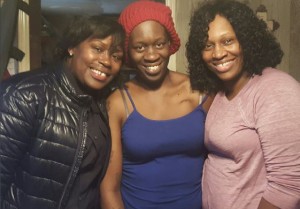
(L-R) Shawanna, Shannon and Yolanda Century. (Photo by Deborah Bailey)
Shannon Century flashes a shy smile as she talks about the day she died back in 2011 while watching TV in her living room. The tall, elegant, 33-year-old mother of two who lives in Mid-Town Baltimore has actually “died” several times since her first episode of sudden cardiac arrest (SCA).
These days, with the watchful support of family, friends and her cardiologist, Shannon lives to raise her teenage daughter, and encourage the dreams of her engaging, six-year old son. Having emerged from more than a handful of SCA experiences, Shannon now sees a new life-purpose on the horizon – educating others about SCA, the nation’s “other” heart disease.
Sudden cardiac arrest (SCA) is the abrupt loss of heart function caused by a malfunction in the heart’s electrical system. SCA can occur without warning. An electrical glitch causes the heart to stop beating and the person loses consciousness immediately. The general public often erroneously thinks of SCA and heart attack as the same medical event, according to the National Heart, Lung and Blood Institute of the National Institutes of Health (NHLB-NIH).
“However nothing could be further from the truth”, said Athol Morgan, Cardiology Specialist at Bon Secours Baltimore Health System and Clinical Assistant Professor of Medicine at the University of Maryland School of Medicine. “SCA and heart attack are two different events. SCA is caused by a problem in the heart’s electrical system”, said Morgan. “We tend to think of the heart as one big muscle. But with SCA, any one cell in the heart can haul off, misfire and cause a problem. “She’s got one bad (heart) cell. In Shannon’s case, we haven’t yet found that cell” said Morgan.
Shannon now wears an implantable cardio defibrillator or ICD. The device is inserted in her chest and automatically sends an electrical jolt to her heart when she has an SCA episode. Shannon had her most recent episode two weeks ago. Dr. Morgan hopes she can undergo another procedure to find that “bad cell” he said.
More than 360,000 “out-of-hospital” SCA’s occur in the US each year – about 1000 per day according to the American Heart Association (AHA). SCA is a leading cause of death and must be treated within minutes for survival. A heart attack, conversely, is due to a blockage in the arteries leading to the heart caused by arterial plaque that builds up over time, according to the NHLB-NIH. Persons are usually conscious while experiencing a heart attack.
African-Americans are almost twice as likely to experience SCA at home, work or in another public location than Caucasians. African-American survival rates are one-half that of Caucasians, according to the AHA.
Most out-of-hospital SCA’s occur at home. An informed bystander can mean the difference between life and death during an SCA event. It is critical for bystanders to administer CPR or hands-only CPR, or to use an automated external defibrillator(AED) to restart the heart while awaiting medical help, according to the AHA. The Maryland Public Access AED program works with churches, schools, health clubs, businesses and other entities to establish AED programs and train volunteers to use the equipment. Baltimore City Fire Department offers free hands-only CPR training.
Shannon’s sisters Shawanna and Yolanda, still marvel that Ariel McFadden, a family friend who was with Shannon the night of her first SCA episode, knew to administer CPR to Shannon immediately. The combination of CPR and the fact that Shannon lives just blocks from Bon Secours Hospital where she was admitted, probably saved her life, said Dr. Morgan. “She’s my miracle” he said.
Shannon’s support team of family, friends and Dr. Morgan remain close. “I don’t want to be somewhere out alone and fall out, so someone is always with me during the day. Sister Yolanda stays at Shannon’s house most nights. Dr. Morgan, is on my mother’s speed-dial” Shannon said.


